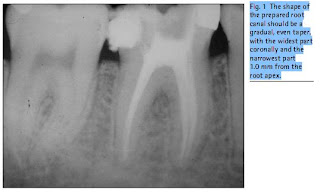The principles of root canal preparation are to remove all organic debris and microorganisms from the root canal system, and to shape the walls of the root canal to facilitate that cleaning and the subsequent obturation of the entire root canal space. However, a tooth root rarely contains a single simple root canal. Accessory canals, lateral canals, fins, anastomoses between canals, and an apical delta all contribute to the root canal system, as shown in Part 1. The majority of these anatomical features are not accessible to instrumentation. An irrigant solution must be used which can be flushed through this system, will destroy the microorganisms and preferably dissolve organic debris at the same time. Thus the current concept of root canal preparation is not cleaning and shaping, but shaping and cleaning. The main root canals should be rapidly and efficiently shaped with instruments to permit thorough and extended cleaning of the entire pulpal system with the irrigant solution. Once shaped and cleaned, the root canal system is obturated to prevent further ingress of microorganisms, both apically and coronally, and to entomb any remaining microorganisms to prevent their proliferation. Currently, the root canal filling material of choice is gutta-percha, which requires a gradual, even, funnel-
shaped preparation with the widest part coronally and the narrowest part at the apical constriction, normally approximately 1.0 mm short of the root apex (Fig. 1). Wide, relatively straight canals are simple to prepare, but fine, curved canals can present considerable difficulties. In the past, a number of techniques have been described, all of which have been designed to produce a tapered preparation.
